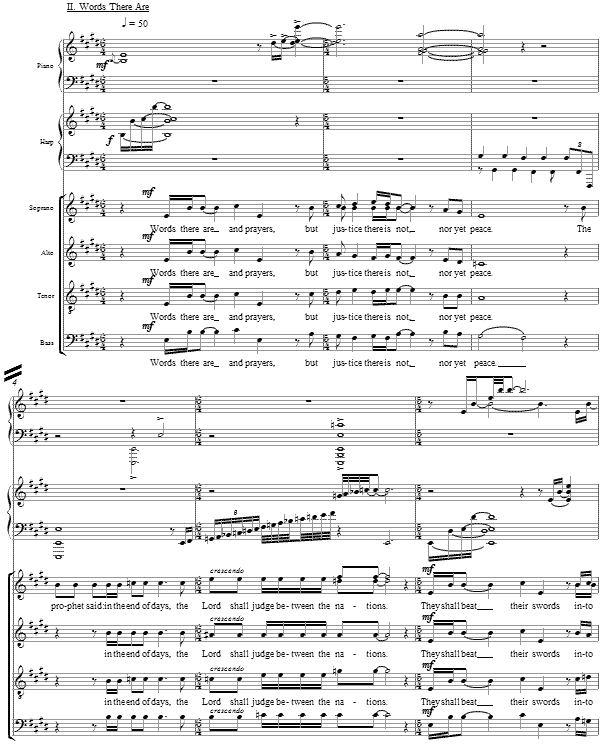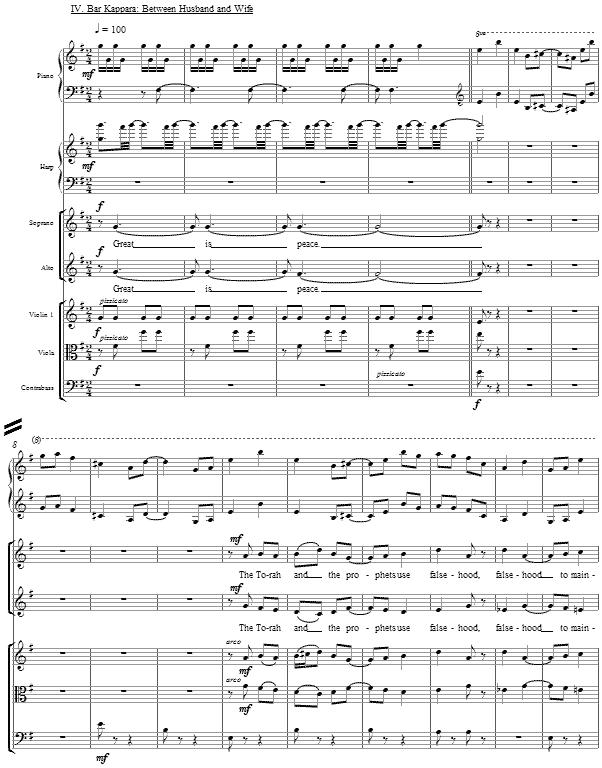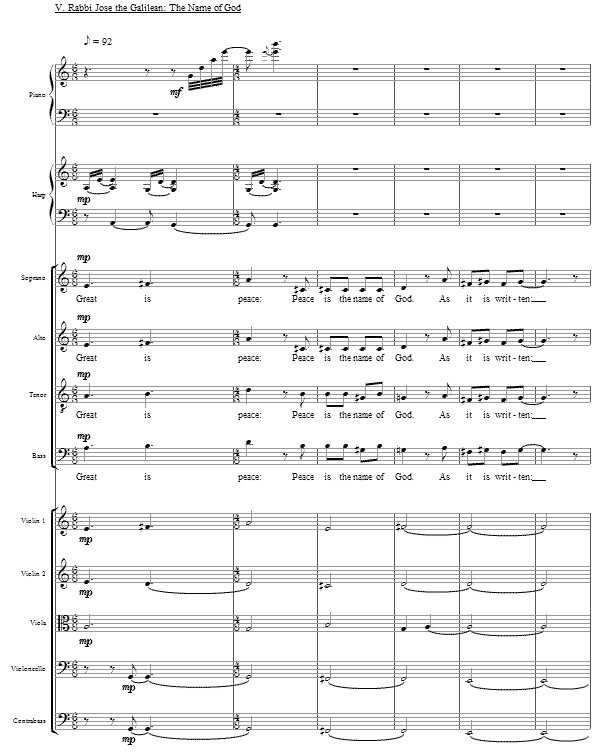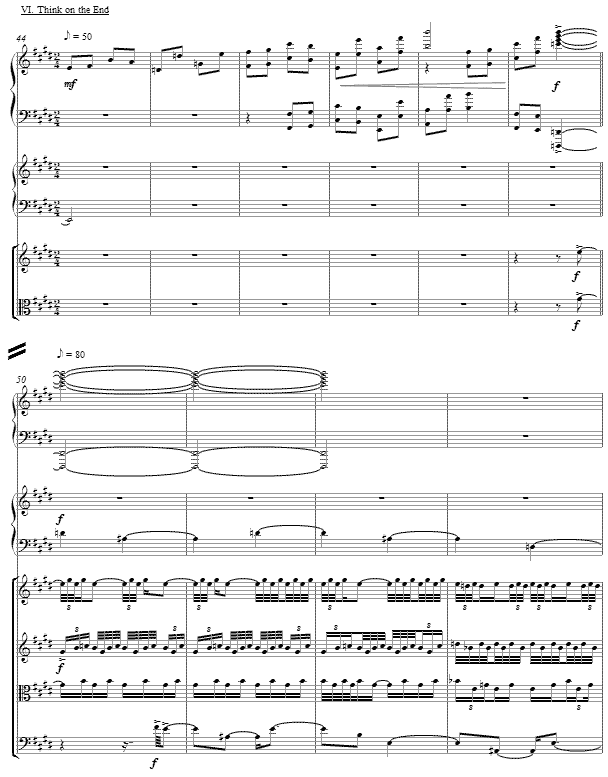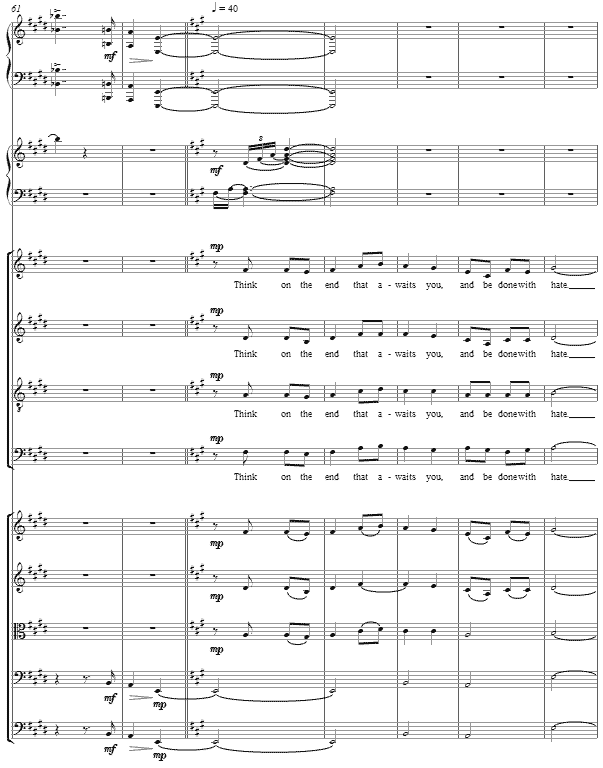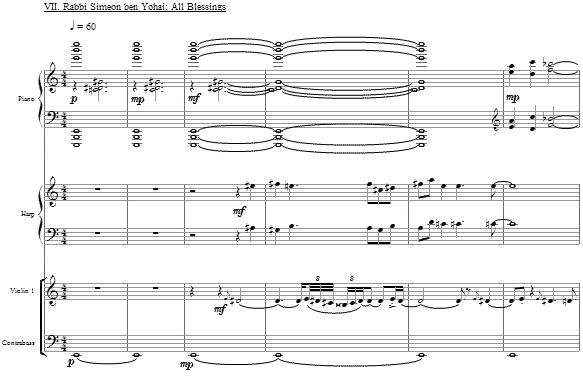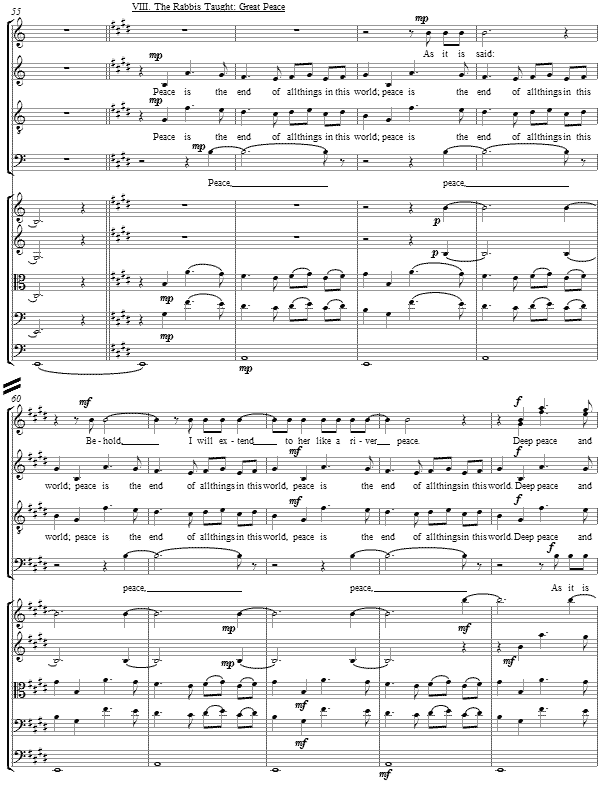Music and Texts of GARY BACHLUND Vocal Music | Piano | Organ | Chamber Music | Orchestral | Articles and Commentary | Poems and Stories | Miscellany | FAQs |
Essays on Peace - (1984)
Compiled from from rabbinic sources by the composer
for SATB divisi, harp, piano and string quintetWritten for the dedication of Ahavat Shalom, the new Reform synagogue in Northridge, California,
with the guidance of Rabbi Solomon Kleinman
Premiered in that year by Kol Echad Chorale, Alan Weiner, director
i. Meditations - instrumental
ii. Words There Are [ 1 ]
Words there are and prayers,
But justice there is not, nor yet peace.
The prophet said: In the end of days
The Lord shall judge between the nations.
They shall beat their swords into plowshares
And their spears into pruning hooks.
Nation shall not lift up sword against nation,
Nor ever again shall they train for war.
Words there are and prayers….
Peace will remain a distant vision
Until we do the work of peace ourselves.
Words there are and prayers….
iii. Hezekiah: Seek Peace [ 2 ]
Great is peace: Man cannot wait for peace.
The psalmist said: Seek peace in your place.
Pursue it wherever it is to be found.
Although we wait for judgment,
We cannot wait for peace to fall like rain upon us.
Seek peace in your place.
iv. Bar Kappara: Between Husband and Wife [ 3 ]
Great is peace: The Torah and the prophets
Use falsehood to maintain peace
Between husband and wife.
For no marriage is made without a quarrel.
For the sake of peace one may lie,
But peace itself must never be a lie.
If peace is to be brought into the world,
It must first be brought to the family.
v. Rabbi Jose the Galilean: The Name of God [ 4 ]
Great is peace: Peace is the Name of God.
As it is written: And he called Him Lord, Peace.
Even on the threshold of war,
We are bidden to begin with peace.
May we see the day when war and bloodshed cease;
We have not come into being to hate or to destroy,
But to praise, to labor and love.
God will fulfill the promise:
To bring peace to let love and justice flow.
Peace is the Name of God: Call him Lord, Peace.
vi. Think of the End
Think of the end that awaits you,
And be done with hate.
If you cherish rage,
Where will you look for pardon?
Forgive others their wrongdoings
That you may be forgiven;
Pardon comes with love as strong as death.
Think of the end that awaits you,
And be done with hate.
vii. Rabbi Simeon ben Yohai: All Blessings [ 5 ]
Great is peace:
In peace are to be found all other blessings.
Feed on love and brotherhood,
And peace reigns.
Peace in your coming in;
Peace in your going out;
Peace with all men.
Great is peace:
It is the seal of all blessings.
viii. The Rabbis Taught: Great Peace [ 6 ]
Peace is the end of all things in this world.
Behold, I will extend peace to her like a river.
Grant us peace, great peace, deep peace,
Mercy, life and love,
And the will to proclaim it
To the nations of the earth.
May the love of Your Name
Hallow every home and every heart.
Unite these fragments of our hearts
To see the light of peace.
Blessed is the Eternal Source of Peace.[ 55 pages, circa 25' 30" ]
The texts used in this libretto for a cantata for chorus suggest clearly that "Peace will remain a distant vision until we do the work of peace ourselves." What is that work of peace? With so many contemporary views as to how peace is to be achieved, Talmudic sources reveal something often missing in the contemporary debate -- a debate which has lasted for millennia, lest we forget this fact. It is to these centuries' old sources that I turned for instruction as well as this libretto.
It seems too easy in the modern day to equate the political peace movement with its ostensible goal, peace. Scriptural references suggest something not so subtly different. One finds in Isaiah 45:6-7 the following: "That they may know from the rising of the sun, and from the west, that there is none beside me. I am the Lord, and there is none else. I form the light, and create darkness: I make peace, and create evil: I the Lord do all these things." The notion of God as first creator of evil as well as of good and war as well as peace has been a theological conundrum for the broad expanse of Judeo-Christian theology in all its variety.
For Jews, this statement is magnified by other Torah sources making the association of good and evil both resident, at the outset, with God. For Christians, the so-called "hard sayings" of Jesus are often avoided in discussion as well. One such saying which modern Christian pacifism avoids may be found in Matthew 10:34. "Think not that I am come to send peace on earth: I came not to send peace, but a sword." Additionally the "end time" visions of Christian scriptures involve warfare in both heaven and earth, a "great day of wrath." [ 7 ] Moreover, in our modern age in which "global jihad" fills news reporting, the notion of God's command to engage in warfare in fundamentalist Islam's theology is also coming under scrutiny and probable correction, as is the fallacy of a generalized secular pacifism.
Then how is the "work of peace" accomplished? This set of texts set to music for chorus and chamber ensemble is one exploration towards answering again the age old question, in the vocabulary of words with music. The vocal range for the chorus is as follows:
The work begins with an instrumental "meditation." Piano and harp offer a quiet background as cantabile strings sing an arching melody.
ii. Words There Are
Following a meditative prelude, the second movement -- "Words there are" -- reminds that, though there may be "words and prayers" aplenty, the measure of peace might be better seen in terms of justice -- for all, and not simply for the few. The concept of justice for only one group with injustice mete out to another in the process of securing justice for some cannot be defined as peace. Nor is peace defined merely the absence of war, a seemingly modern yet very old argument without merit. Rather, peace is something more profound that the absence of war itself.
The third chapter of Ecclesiastes, verse eight instructs that there is a "time to love, and a time to hate; a time of war, and a time of peace." As there is a time for war, biblically stated, there is a time for peace. The great rabbis and sages saw this distinction which now is often lost in the simple pacifistic rhetoric the modern peace movement. Peace requires "the work of peace" be accomplished, which is not merely with "words and prayers." The choir begins in unison and breaks into a pyramid to remind that justice "there is not." The movement moves between dramatic and lyrically meditative sections with instrumental interludes.
iii. Hezekiah: Seek Peace
The third movement, "Hezekiah: Seek Peace," identifies one of the voices which instruct us of peace. The text says suggests that man cannot wait for peace, but must take an active role in its creation.
Hezekiah is a historical figure, who reigned in the era when Assyrian empire was consolidating control over what is now Israel, the Palestinian territories and modern day Syria. Hezekiah, scholarship informs, was a warrior and possible leader of a rebellion against Sennecheirb (705-681 BCE). Among the works of Hezekiah is the engineering of the Siloam tunnel (II Kings 20 and II Chronicles 32) which brought water from the Gihon springs to a reservoir inside the city walls of Jerusalem. [ 8 ] Therefore the work of peace in part might be historically seen as preparations for war when necessary.
A direct segue from the second movement begins with a cadenza-like gesture for violin and then violoncello. An initial three-voice
iv. Bar Kappara: Between Husband and Wife
The fourth movement addresses peace within the family, the most personal and smallest social entity. Rabbis concluded the notion of tikun olam, that the repair of the world is an individual as well as social act, and that the world's repair must take place through individual acts. "If peace is to be brought into the world, it must first be brought to the family." For that, small "white" lies which were generally harmless were advised.
In the modern day which seems to easily dominated by a secular theology and "arm chair" psychology, the urge to be "open" is sometimes destructive to the simple civility which aids peace in the family. "Let it all hang out," a modern inanity, is evil counsel, whereas "falsehood to maintain peace between husband and wife" might be the better counsel. The musical setting therefore jokes with the English word, "lie," and the niggun-like [ 9 ] setting for women's voices.
The soprano and alto sing parallel diatonic sevenths, doubled by strings, as the texture echoes a classical niggun, the word "lie" functioning as a nonsense syllable does in such wordless song.
v. Rabbi Jose the Galilean: The Name of God
The fifth movement simply suggests that "Peace is the Name of God." Perhaps one of the great conflicts between religious cultures has been the argument over the name of God. The tetragrammaton, the four consonants of the ancient Hebrew name for God was once deemed to sacred to be spoken aloud. Inserting the vowels from Adonai or Elohim into the consonants has been variously transliterated as the modern reconstructions of Jehovah, Yahweh and so forth.
Whole religious denominations have been constructed and named based on such "known" naming of a name once considered to sacred to be spoken aloud. Similarly, in religious and cultural conflicts, often the allegiance to one "right" name for God as opposed to another "wrong" name for God has motivated hatred and genocide. The ancient root of the name has its antecedents in the modern Jewish, Christian and Muslim names which have been excuses for conflict and warfare. Therefore, as the text drawn from ancient rabbinic sources suggests, one might better think that "peace is the Name of God" in any language or culture.
The sages speak again of war. "Even on the threshold of war, we are bidden to begin with peace." This lengthy argument spanning Talmudic and later works is originally found in Deuteronomy 20:10-12, " When you come nigh unto a city to fight against it, then proclaim peace unto it. And it shall be, if it make thee answer of peace, and open unto thee, then it shall be, that all the people that is found therein shall be tributaries unto thee, and they shall serve thee. And if it will make no peace with thee, but will make war against thee, then you shall besiege it."
A difficult passage as regards tribute and issues since further clarified by other scriptural evidence, but the central theme is that peace must be offered even in the moment of war. Begin with an offer of peace, and end with an offer of peace. The chorus sings in block harmonies in a litany of sorts, reciting the text with meter changes as the words require for their emphasis.
vi. Think of the End
The sixth movement confronts us with the clear question, "If you cherish rage, where will you look for pardon?" Nehemiah 9:17 in part states, "but thou art a God ready to pardon, gracious and merciful, slow to anger, and of great kindness, and forsook them not." These are elements worth modeling -- being slow to anger and ready to pardon. For those who refuse to hold this view, whether they be militant aggressors or the apologists for militant aggressors as history has so often shown, being "ready to pardon" is the better path towards peace.
Strength with mercy rather than weakness with an inability to pardon will out in the end, suggests the message found across scriptural evidence so often disregarded as inconvenient, whether it is a message of compassion in the Torah and Talmud, the various Christian versions of the bible, or the Q'uran and its commentaries found in the Hadith. Without compassion, neither warfare nor the waging of peace are to be successful. For both the undertakings of waging war by any name or "waging peace" in the sense of modern activists, sage advice is to "think of the end that awaits you." If the end is surrender, the end will not be peace in the rabbinic sense but enslavement, discord and evil.
Given this picture, the movement -- a direct segue from the fifth -- opens with a quickly building gesture in the solo piano after which a confused murmur of strings leads into a drama of fortissimo proportions.
The retreat of the dramatic instrumental colors leaves clear a sweet choral moment, the upper strings doubling the voices, as we are reminded to "think on the end."
vii. Rabbi Simeon ben Yohai: All Blessings
The seventh movement advises that peace is the foundation upon which other blessings of life are firmly rooted. Peace is a fundamental blessing, and not, as so often naively described, merely the absence of war. The Mishna praises the duty of being a peace-maker.
Yet the Hebrew word for peace, shalom, simply does not mean the absence of conflict and warfare. Rather it was used for centuries in biblical and scriptural commentary by the great rabbis to mean specifically a sense of well-being and tranquil security. Further, the word does not denote a passive stance, but implies clearly a call to action to assure well-being and tranquility. In this sense, peace is indeed the platform upon which other blessings rely.
As with previous movements, an instrumental curtain between the blocks of texts echoes earlier musical materials, the solo violin again in a cadenza-like meditation.
The harmonic language vacillates between E major and G minor, both appearing polytonally in the accompaniment.
viii. The Rabbis Taught: Great Peace
This last movement summarizes the notion that great rabbis taught the same lesson in various ways, as this sampling of their writings is meant to indicate. "Peace is the end of all things in this world" informs us that even warfare strives to arrive at peace, while "words and prayers" about peace are sometimes quite empty absent the actions to make those words and prayers into real behaviors.
The meaning of this last movement requires of us the will to proclaim "peace to the nations of the earth." If words and prayers are not enough, then proclamation must be by action and by example -- wherein the "fragments" of the heart are united into productive, merciful action. The outcome of right behaviors biblically are spoken of in the metaphor of flowing water -- mayim hayim. [ 10 ] In order to experience this trust is required. Isaiah 26:3 says "Thou wilt keep him in perfect peace, whose mind is stayed on thee: because he trusts in thee."
The lesson herein is that trust in God, words and prayers when united with rightful deeds -- which seem obviously to include warfare when necessary -- and an emphasis on the individual's responsibility to act within the family as well as within the world at large are all aspects of the same greater fabric of peace, as the great rabbis understood it. May we be so wise in our modern perception of these old truths, taught by the great historical rabbis throughout the ages.
As with earlier movements, this last is a direct segue, as the chorus sings emotional repetitions in thirds with an underlying dominant pedal over the tread of tonic-subdominant in long strides in the contrabass.
A final stirring summation with unison chorus and glissandi in the harp gives way at the end to a shrinking texture, the violins risings in sixths to a final pianissimo cadence.
Rabbi Solomon Kleinman
Rabbi Kleinman of Temple Ahavat Shalom gave great help in the selection of texts, during our conversations about the work. Herein I thank him for his generosity of spirit, erudition and wisdom. For more on Solomon Kleinman, please see the page for my setting in his honor, Vayomer shalcheini.
The full score for Essays on Peace is available as a free PDF download, though any major commercial performance or recording of the work is prohibited without prior arrangement with the composer. Click on the graphic below for this score. For piano-vocal and instrumental parts, please contact me directly per the information found in "Miscellany."
NOTES
[ 1 ] References to "swords into plowshares" and "spears into pruning hooks" come from the inverse of this process, which is the preparation for war, as is found in Joel 3:9-11. "9. Proclaim ye this among the Gentiles; prepare war, wake up the mighty men, let all the men of war draw near; let them come up: 10. Beat your plowshares into swords and your pruning hooks into spears: let the weak say, I am strong. Assemble yourselves, and come, all ye heathen, and gather yourselves together round about: thither cause thy mighty ones to come down, O Lord."
But at the positive end of war, one finds the opposite, as in Micah 4:1-3. "But in the last days it shall come to pass, that the mountain of the house of the Lord shall be established in the top of the mountains, and it shall be exalted above the hills; and people shall flow unto it. And many nations shall come, and say, Come, and let us go up to the mountain of the Lord, and to the house of the God of Jacob; and he will teach us of his ways, and we will walk in his paths: for the law shall go forth of Zion, and the word of the Lord from Jerusalem. And he shall judge among many people, and rebuke strong nations afar off; and they shall beat their swords into plowshares, and their spears into pruning hooks: nation shall not lift up a sword against nation, neither shall they learn war any more."
[ 2 ] Reference here is to Psalm 34:14, which states clearly "Depart from evil, and do good; seek peace, and pursue it."
[ 3 ] Bar Kappara was son of a rabbi and a famed rabbi in his own right of the late second and early third century CE, during the period between the tannaim and amoraim, and active during the period circa 180 to 220 CE. Tanna is the Aramaic word for teacher, and its plural is tannaim. The term refers to approximately 200 scholars who compiled an oral tradition about reigious law over two centuries, most of their work done in Palestine and given final form in the Mishna. The Tannaim were suceeded by the "Amoraim," which means interpreters or reciters; it was this later group of scholars who wrote the extensive commentaries on the Mishna -- the Gemara.
Bar Kappara's name was taken as "son" of Elazar Ha-Kappar. A talented storyteller and poet as well, a prayer of his appears in the Jerusalem Talmud, and was incorporated into the prayer book's lengthy Amidah. He advocated studying Greek as well as Hebrew, and suggested that the words of Torah should be said in many languages. He also advocated the study of natural sciences on the basis of not doing so would be like the Talmudic phrase, "But they regard the works of the Lord not." [Shabbat 75a and Isaiah 5:12]
Bar Kappara notes that the scriptures allow a falsehood for peace between husband and wife, finding it in Genesis 18:12, wherein Sarah complains about not having a child because her husband is "also" too old, and not because she says "I am too old."
One finds the same notion served by the quote, "He who makes peace in his own home is as if he made peace in all Israel." [Avot deRabbi Natan, 28:3] The notion of peace within the family is further encouraged by "...you shall know that your tent is in peace." [Job 5:24]
[ 4 ] Rabbi Jose the Galilean (fl. 1st and 2nd centuries CE) was a tanna, a contemporary of famed rabbis Akiba, Tarfon and Eleazar ben Azariah. Though modest, Jose was a thorough scholar which brought him equal status among his peers at the Academy at Jabneh, and he is reputed to have won in disputes with the acknowledged master of the time, Akiba. Yet he was said to be magnanimous, changing sides in a debate when the line debate proved him wrong, a quality lacking in much modern day philosophy, economics and politics -- the so-called social sciences which cannot reach clear consensus in spite of their posture as "sciences."
[ 5 ] Rabbi Simeon ben Yohai (fl. 2nd century CE) was also a Galilean tanna. The authorship of the Zohar, Kabbalah's core text and most important work on Jewish mysticism, is attributed to him, although the text itself did not surface until the 13th century; modern scholarship attributes the Zohar to 13th century mystic, Moses de León.
Among the students of Simeon was the influential Judah ha-Nasi, redactor of the Mishna in which many of Simeon's aphorisms are recorded. Among his emphases was the clear notion that Jewish law -- both ritual and civil -- had to be interpreted and indeed modified according to the spirit in which the law was originally authored. He acquired the reputation of both a mystic and a miracle worker, as later stories tell, though his central emphasis was ever on the study of the Torah -- the bible.
[ 6 ] Reference here is to the metaphor of the river and moving water, as for example in Isaiah 48:18. "O that thou had hearkened to my commandments! Then had thy peace been as a river, and thy righteousness as the waves of the sea." Also, in Isaiah 66:12. "For thus says the Lord, Behold, I will extend peace to her like a river...."
[ 7 ] Revelations 6:17. Those kinds of passages in Christian gospels and additional books are often ignored, as if not part of the canon; the texts most assuredly are wholly biblical, no matter how inconvenient to the modern dialectic of pacifist politics which awkwardly sidesteps the aforementioned inconvenience. The Judeo-Christian culture has regularly advocated the "just war."
That concept found its way through Augustine in the 4th century CE through to the more modern history of Grotius' De Jure Belli ad Pacis (1625), through to the Declaration of Paris (1856), the Geneva Conventions (beginning in 1864 and through to 1949), the Declaration of St. Petersburg (1868), the Geneva Protocol on Gas Warfare (1925), the Kellogg-Briand Pact (1928), the United Nations Charter (1945), the Hague Convention (1954), the United Nations Convention on Military and Any Other Hostile Use of Environmental Modification Techniques (1977) and the Geneva Protocols (also 1977).
The assertion that international law bans war in order to "wage peace" is without basis in fact. All of the aforementioned treaties and understandings are attempts to manage war, allowing some while disallowing others by mechanism of international agreements. Moreover, as duly noted by several commentators, the legalistic approach to abolishing war is "futile" in the absence of a means of enforcement, the only enforcement against the obstinate conduct of warfare being logically warfare as the appropriate if tragic response.
Peace therefore, as was concluded by the great rabbis millennia ago, is not an absence of war, but a wholly other concept for conducting life and seeking the blessings of that life. Without that active approach to seeking peace in the family, in society and throughout the world even to the use of war when necessary to correct injustice, there can be no lasting peace. The sages ask us to contemplate our individual lives as vehicles for peace, which in the context of the modern state, regional and international agreements might seem antiquated. It is however the more modern yet centuries' old answer sought again in each generation.
[ 8 ] II Kings 20:20. "And the rest of the acts of Hezekiah, and all his might, and how he made a pool, and a conduit, and brought water into the city, are they not written in the book of the chronicles of the kings of Judah?"
[ 9 ] A niggun -- or nigun in an alternative transliteration -- is a wordless song sung by Hasidic Jews as a means of elevating the soul to God. Thought to more clearly reach a mystic understanding beyond the sensual or rational because of the absence of text, such songs were often extemporized by a rabbi and taken up by his followers. Some that survive in musical notation evidence a clear Slavic folk song style, indicating their possible musical and cultural origins.
[ 10 ] This is the concept of "living water" from which the Jewish tradition derives ritual bathing -- the mikvah -- and from which Christianity has drawn the ritual of baptism, a washing with its "living" water. Other religions also have some ritual involving water, whether as anointing or immersion.




